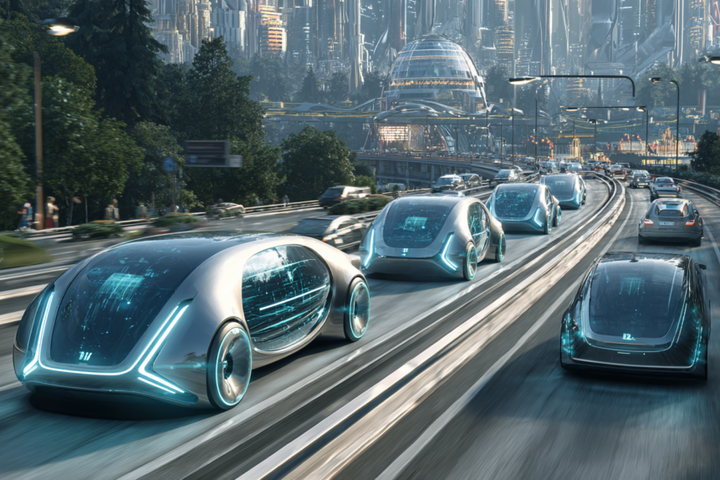
Autonomous vehicles, or AVs, are no longer a distant dream or science fiction—they're hitting roads, farms and factories worldwide as breakthroughs in artificial intelligence spark a commercial revolution across a $1.2 trillion industry.
In a report shared with clients on Tuesday, Bank of America indicated that AVs have reached a pivotal inflection point thanks to dramatic advances in AI, simulation, and computing power.
To date, autonomous robotaxis have completed 186 million commercial miles as of April 2025. These vehicles are now operating in seven global cities, with plans to expand into 20 additional markets in the near future.
“Autonomous vehicles are having their ‘ChatGPT moment' and are no longer a moonshot," said the bank’s analyst Martyn Briggs.
See Also: Palantir Stumbles, Solar Stocks Rally As Senate Approves Tax Bill: What’s Moving Markets Tuesday?
AI, Not Just Automation, Is Driving The AV Revolution
Unlike earlier generations of self-driving systems, which relied on hard-coded software and maps, the latest wave of AVs is driven by "physical AI," according to the report.
This includes neural networks that continuously learn from real-world data and simulation environments known as "digital twins," which drastically reduce the need for on-road testing.
New capabilities like language models are adding "reasoning and interpretability to driving decisions," Briggs said, while supercomputers integrated into vehicles are enabling autonomous driving in new geographies and use cases.
The cost to deploy AVs is also falling. Hardware, such as LiDAR sensors, is getting cheaper.
Market Potential: Not Just Cars—Everything That Moves
The AV market is broader than just robotaxis. While cars represent a $700 billion opportunity by 2040, Bank of America estimates the total addressable market doubles to $1.2 trillion when including autonomous trucks, public transit, agricultural and mining vehicles.
Some off-road AVs are already commercially available, with reported gains of 30% in productivity and 50% labor cost savings in industries like agriculture and mining.
Robotrucks are set to disrupt the $4 trillion global freight market. Autonomous trucking is accelerating fast, with 90 active pilot programs worldwide—two-thirds of which target long-haul freight.
Seven of these pilots are nearing commercialization, with the goal of large-scale rollouts by 2027. Briggs said the freight industry is poised for transformation as AVs address "structural challenges like driver shortages" while reducing costs.
The story is no longer just about cars: “Anything that moves could become autonomous," Briggs said.
How to Invest In Autonomous Vehicle Market: 28 Stocks To Watch
The Bank of America report identifies 28 publicly traded companies across six sub-sectors—vehicle manufacturers, mobility platforms, software, sensors, semiconductors and insurance—with a combined market cap of approximately $9 trillion.
Original Equipment Manufacturers (OEMs):
- Caterpillar Inc. (NYSE:CAT): Dominates autonomous mining trucks
- Deere & Co. (NYSE:DE): Precision farming with autonomous tractors
- Toyota Motor Corp. (OTC:TOYOF) and Hyundai Motor Co. (OTC:HYMLF): Partnered with Waymo and Aurora
- XPeng Inc. (NYSE:XPEV): Advanced driver-assistance systems (ADAS) and autopilot EVs
- Daimler Truck Holding AG (OTC:DTGHF): Global leader in heavy-duty autonomous trucks
- Xiaomi Corp. (OTC:XIACF): Integrating LiDAR and autopilot tech into smart vehicles
Mobility Platforms:
- Uber Technologies Inc. (NYSE:UBER): Expanding AV ride-hailing with Waymo, Aurora and WeRide partnerships
Software Providers:
- Amazon.com Inc. (NASDAQ:AMZN): Building purpose-built AVs through Zoox
- Alphabet Inc. (NASDAQ:GOOG): Operating Waymo robotaxis across U.S. cities
- Dassault Systemes SE (OTC:DASTF): Offers digital twin simulations and AV design platforms
- Baidu Inc. (NASDAQ:BIDU) and Pony.ai (NASDAQ:PONY): Operating robotaxis and robotrucks in China
Sensor Companies:
- Aptiv PLC (NYSE:APTV), Denso Corp. (OTC:DNZOF), Allegro MicroSystems Inc. (NASDAQ:ALGM): Supplying ADAS sensors, radar, and steering systems
- Hesai Group (NASDAQ:HSAI) and RoboSense (OTC:XEDSF): Global leaders in LiDAR tech
Semiconductor Leaders:
- Nvidia Corp. (NASDAQ:NVDA): AV chips, AI training, simulation, and supercomputing platforms
- Qualcomm Inc. (NASDAQ:QCOM), Mobileye Global Inc. (NASDAQ:MBLY), NXP Semiconductors NV (NASDAQ:NXPI): Enabling computer vision and ADAS systems
- Infineon Technologies AG (OTC:IFNNF), STMicroelectronics NV (OTC:STMEF), Horizon Robotics (OTC:HRZRF): Leading providers of AV-specific silicon and AI hardware
Insurance:
- Progressive Corp. (NYSE:PGR): Developing AV insurance products tailored for new risk profiles.
Surprisingly, one name was notably absent from the Bank of America’s list of autonomous vehicle investment picks: Tesla Inc. (NASDAQ:TSLA).
Now Read
Image: Midjourney







